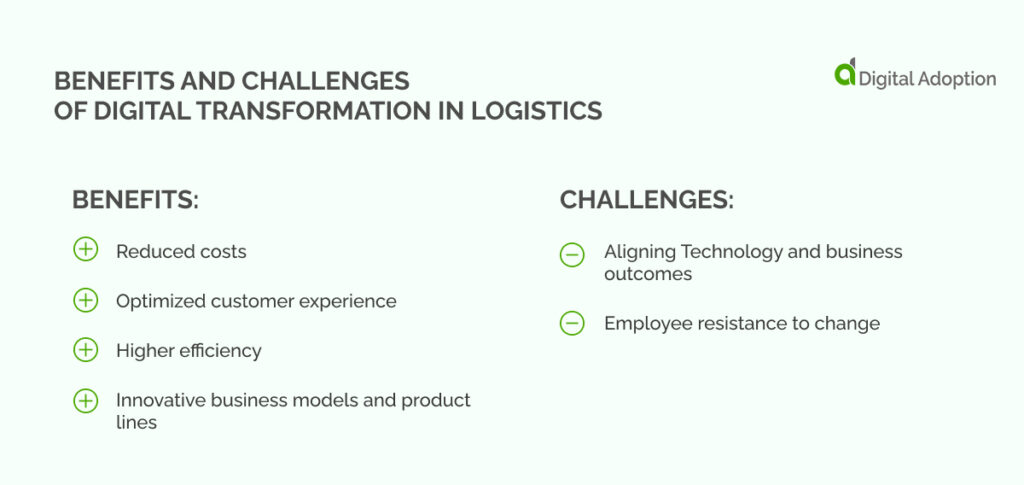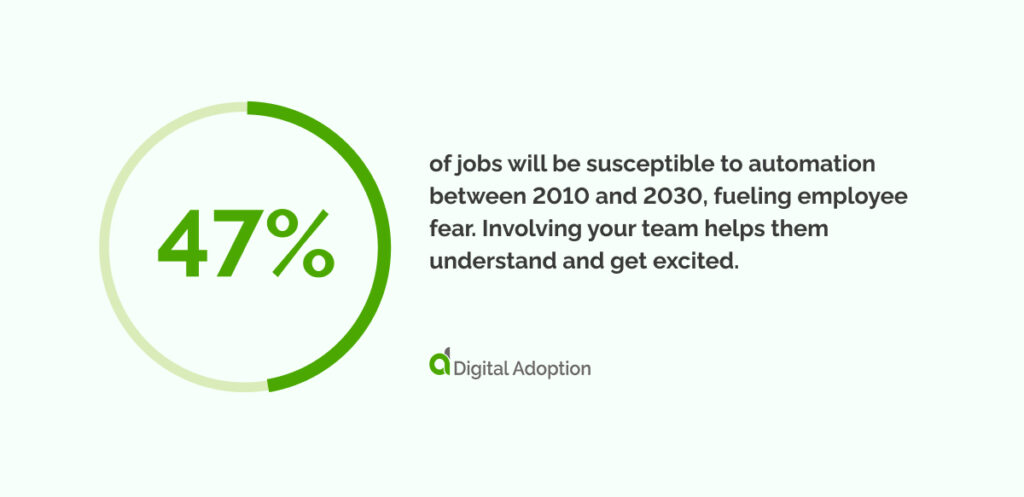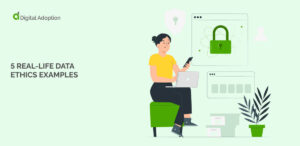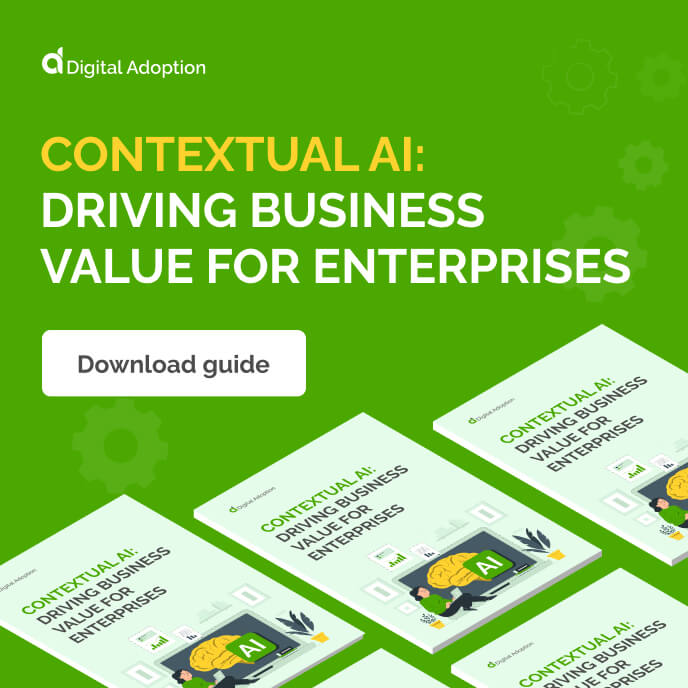Digital transformation fits right into the logistics sector and its changing needs.
Delivery of items to customers aligns with automation with packing and sorting items. We also see innovative ideas that wow customers, like Amazon’s drone delivery.
Now, futuristic drones do not suit every logistics enterprise. But many other digital transformation technologies do. Blockchain, AI analytics, and logistics automation have universal benefits and use cases for many enterprises.
The facts about digital transformation spending speak for themselves. Predictions suggested logistics companies would spend USD 2.3 trillion on digital transformation in 2023. Targeting such large amounts of spending is essential. Equip your staff with digital transformation skills, and plan to ensure ROI.
Let us guide you through the role of digital transformation in logistics, beginning with what this concept is, then moving on to three examples of digital transformation in logistics, and ending with the benefits and challenges of these technologies in a transformation.
What is digital transformation in logistics?
Digital transformation in logistics involves using technology to improve processes. Examples of technologies include workflow automation, blockchain, and data analytics.
Implementing these new technologies boosts employee efficiency and customer satisfaction. It also distinguishes your logistics and transportation company from rivals. Doing so increases revenue as you gain customers.
What are some examples of digital transformation in logistics?
Digital transformation is revolutionizing traditional operations and logistics processes. Let’s examine how enterprises have used new technologies to innovate and drive efficiency, beginning with the retail giant Amazon.
Amazon: Logistics automation
The company leverages advanced technologies to streamline operations and deliver exceptional customer experiences. A key area of excellence for Amazon is warehouse management.
Amazon has transformed its warehouses into highly efficient order fulfillment centers. It uses logistics automation systems and digital platforms.
With over 500,000 mobile robots deployed, Amazon has significantly enhanced inventory management, reduced delivery times, and expedited order processing. This automation enables Amazon to offer fast, reliable delivery services. It sets new industry standards in speed and efficiency.
What can you learn from this example?
There are several lessons we can learn from Amazon’s logistics digital transformation, including:
- Efficiency through automation: Amazon’s 500,000 mobile robots enhance inventory management, speed processing, and reduce delivery times.
- Innovative delivery solutions: Amazon’s drones show cutting-edge technology’s potential for faster, cost-effective last-mile delivery.
- Customer-centric approach: Amazon’s focus on fast, reliable delivery highlights the importance of prioritizing customer satisfaction.
Maersk: Blockchain
Maesrk leverages blockchain’s decentralized and transparent nature. As a result, it has streamlined its documentation processes and improved supply chain visibility.
Traditionally, the shipping industry encountered extensive paperwork, delays, and errors. Blockchain allows Maersk to create a secure, immutable digital ledger that tracks and verifies each shipping process step.
This process reduces paperwork, minimizes disputes, and enables real-time shipment monitoring.
As a result, Maersk has enhanced efficiency, reduced costs, and improved customer service through its digital logistics initiatives powered by blockchain.
What can you learn from this example?
There are several lessons we can learn from Maersk’s logistics digital transformation, including:
- Streamlined documentation: Blockchain reduces paperwork and errors, creating a secure, immutable digital ledger.
- Enhanced visibility: Real-time shipment tracking with blockchain improves supply chain transparency and efficiency.
- Cost reduction: Blockchain minimizes disputes and delays, leading to significant cost savings in supply chain management.
UPS: AI language platform
UPS utilizes artificial intelligence via its Languages Across Logistics (LAL) platform to overcome language barriers. It helps ensure inclusivity for UPS staff globally as part of their AI-augmented workforce.
The technology, supporting over 20 languages, fosters diverse hiring across 20 countries, reinforcing UPS’s commitment to inclusivity. It has become the core of their latest AI-driven digital transformation.
LAL exemplifies UPS’s commitment to enhancing operations and employee experiences through innovative solutions.
The positive impact of these technologies will impact job safety and ease, underscoring UPS’s dedication to improving employee well-being while advancing industry standards.
What can you learn from this example?
There are several lessons we can learn from UPS’s logistics digital transformation, including:
- Communication is key to any transformation: UPS’s LAL allows employees of many nationalities to communicate and drive transformations quickly.
- Inclusivity drives innovation: UPS’s LAL AI breaks language barriers, fostering a diverse and welcoming workplace culture.
- Efficiency speeds up transformations: Multilingual support streamlines training and communication, boosting productivity in global operations.
By leveraging advanced technologies, Amazon, Maersk, and UPS have transformed their operations and set new standards in logistics.
Amazon’s logistics automation, Maersk’s blockchain-based supply chain management, and UPS’s use of AI exemplify how digital transformation can drive innovation, efficiency, and superior customer experiences.
What are the benefits of digital transformation in logistics?

Digital transformation initiatives require time and effort. However, their benefits are always worth the investment, leading to positive changes for employees and customers.
See below for a detailed list of the logistics digital transformation advantages you can expect.
Reduced costs
The first point is that digital transformation drives substantial cost savings across all your logistics operations. You can utilize automation to reduce labor costs. Doing so minimizes repetitive tasks for staff, allowing them to focus on higher-level tasks.
Data-driven route optimization reduces fuel expenses and carbon emissions, helping progress toward sustainability goals as you implement your data transformation. The process enhances efficiency in warehousing and inventory management. It also improves transportation and last-mile delivery, reducing operational costs.
Optimized customer experience
In today’s market, customer expectations for fast, transparent delivery are higher than ever. These expectations and needs change over time, requiring agile approaches within your transformations.
Digital solutions help meet and surpass these shifting expectations, building trust and satisfaction. Use web and mobile applications to allow your customers to track orders and communicate problems directly to customer service.
Also, don’t overlook the power of generative AI applications for a logistics company. AI-powered chatbots provide instant, 24/7 self-service support. Additionally, predictive analytics anticipates customer needs, offering personalized recommendations.
Higher efficiency
Supply chains often grapple with inefficiencies and lack of real-time visibility. Digital transformation addresses these issues effectively. Automated warehousing and inventory management systems reduce manual efforts and human errors, leading to more streamlined operations.
Innovative business models and product lines
Digital transformation enables the introduction of innovative services beyond traditional transportation. Examples include drone deliveries and autonomous trucks, which offer fast fulfillment.
Digital freight marketplaces connect shippers with carriers. The carriers have extra space. The services are new. They offer big revenue opportunities. These are for companies that think ahead in logistics.
Overall, digital transformation reduces costs and enhances customer experience. It also boosts efficiency and enables new business models. These benefits position logistics leaders for future success.
What are the challenges of digital transformation in logistics?
All these opportunities for your logistics enterprise come with its own set of challenges. You need to overcome these challenges before you can enjoy the success of your investment.
Here are some pitfalls to remember when undertaking digital transformation:
Aligning Technology and business outcomes
Doing digital transformation just to do it can waste resources. Aligning your technology investments with strategic goals is essential. They must fit the top priorities. Track key metrics to measure ROI and performance. Make sure that your digital investments drive real business results.
Employee resistance to change
47% of jobs will be susceptible to automation between 2010 and 2030, fueling employee fear. Involving your team helps them understand and get excited.

Overcoming resistance requires good change management. It ensures a smooth transition. Involve those most impacted. Communicate the reasons for the transformation. Emphasize its benefits to gain stakeholder buy-in and alignment.
Outdated systems and technologies are significant roadblocks. Existing logistics and transportation infrastructure often lack the flexibility to adapt to new digital requirements, making integration with modern solutions complex. However, recognizing the need for change is crucial.
Bridging the employee skills gap
Digital transformation hinges on digital proficiency. You need these programs. They will fill the gap in your workforce’s skills using new tools and digital abilities. The right support lets employees use new tech with confidence. It has a big impact.
In 2023, 69% of HR professionals believed their organizations suffered from a skill gap, a 14% increase from 2021. 50% of professionals believe their skills have a shelf life of 2 years. These statistics show that skills for new hires and existing employees need regular updates to equip them with the skills to use new technologies in their logistics enterprise.
A digital adoption platform (DAP) offers guidance in apps. It also provides support for when you need it. The advice and support fit your company’s workflows and digital experiences. DAPs have no-code visual editors. They let non-technical team members create engaging in-app experiences.
With a DAP, you can create:
- Tours and task lists: Onboard new users with guided experiences.
- Flows: step-by-step guidance for complex, multi-step workflows.
- Intelligent tips: Contextual support and information at the moment of need.
- Pop-ups: Announcements, reminders, and feature/process change alerts.
- In-app surveys: Collect feedback from employees and customers interacting with your digital platforms.
By using a DAP, you can improve data accuracy through in-app guidance, self-help support, and process change alerts.
Deliver value with your logistics digital transformation
Focusing on your staff is the key to adding value to your logistics digital transformation. They carry out the change and help the enterprise transform. They do this to cut costs, work better, and serve customers better. Always try to support your staff. The benefits will come fast and become part of your culture.
Consider the challenges. They bring a digital change to your company. You will face two big challenges. The first is bridging the employee skill gap. The second is getting staff to accept change. Meet with staff and plan how to beat these challenges. Do this before the change starts.
This approach will protect you from lost income. You use it while working with staff to provide value to customers and staff. By doing so, you will get higher revenue. You will also get a good business reputation for years to come.













